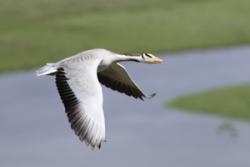Running geese give insight into low oxygen tolerance
 Bar-headed geese.An international team of scientists, led by Bangor University and funded by the BBSRC, recently tracked the world’s highest flying bird, the bar-headed goose, while it migrated across the Himalayas. Now they have shown how these birds are able to tolerate running at top speed while breathing only 7% oxygen.
Bar-headed geese.An international team of scientists, led by Bangor University and funded by the BBSRC, recently tracked the world’s highest flying bird, the bar-headed goose, while it migrated across the Himalayas. Now they have shown how these birds are able to tolerate running at top speed while breathing only 7% oxygen.
Exercising at high altitude is a massive challenge since at the top of the highest mountains the air is only made up of 7% oxygen, compared with 21% at sea level. This is why human climbers often use supplemental oxygen when climbing the world’s highest peaks.
Dr Lucy Hawkes, formerly of Bangor University, and currently at the Centre for Ecology and Conservation at the University of Exeter, led the study, along with her colleagues Dr Charles Bishop (School of Biological Sciences, Bangor University) and Prof. Pat Butler (University of Birmingham). They tested how good the geese were at coping with exercise in reduced oxygen environments by simulating the conditions of Mount Everest in a clear box and then getting the birds to run as fast as possible on a treadmill inside the box.
They discovered that the geese had a remarkable tolerance of low oxygen conditions – at rest and while they were exercising for 15 minutes at top speed – at oxygen levels that would render most humans completely immobile. The researchers also conducted the experiments with the barnacle goose, which migrates at sea-level, and found that they did not have the same ability in low oxygen conditions.
Dr Lucy Hawkes said: “It all seems to come down to how much oxygen bar-headed geese can supply to their heart muscles. The more they can supply, the faster they can beat their hearts and keep the supply of oxygen to the rest of the body going.”
 Bar- headed goose in flight in its native Mongolia.: Image:Nyambayar BatbayarBar-headed geese and barnacle geese undertake similar long distance migratory flights between breeding and wintering grounds, usually covering thousands of miles, during the autumn and spring. Bar-headed geese travel from Indian wintering grounds and high Asian breeding grounds in China and Mongolia, which means that they have to cross the Himalayan Mountains en route while flying as high as 7,290m (23,917ft).
Bar- headed goose in flight in its native Mongolia.: Image:Nyambayar BatbayarBar-headed geese and barnacle geese undertake similar long distance migratory flights between breeding and wintering grounds, usually covering thousands of miles, during the autumn and spring. Bar-headed geese travel from Indian wintering grounds and high Asian breeding grounds in China and Mongolia, which means that they have to cross the Himalayan Mountains en route while flying as high as 7,290m (23,917ft).
The animals have been shown to possess a number of specific physiological adaptations that may increase their performance relative to other species of geese when exposed to severe environmental hypoxia (inadequate oxygen supply). In particular, their heart and locomotor muscles contain more blood vessels.
The study, ‘Maximum running speed of captive bar-headed geese is unaffected by severe hypoxia’ by Lucy A Hawkes, Patrick J Butler, Peter B Frappell, Jessica U Meir, William K Milsom, Graham R Scott & Charles M Bishop is published today in the journal PLOS ONE.
Publication date: 8 April 2014
